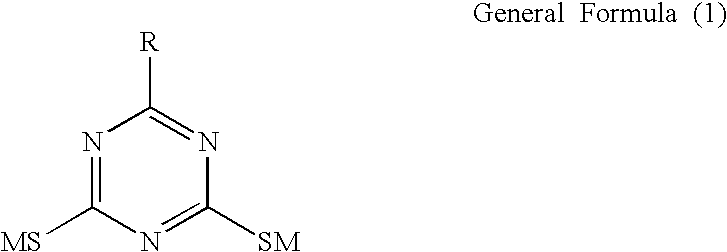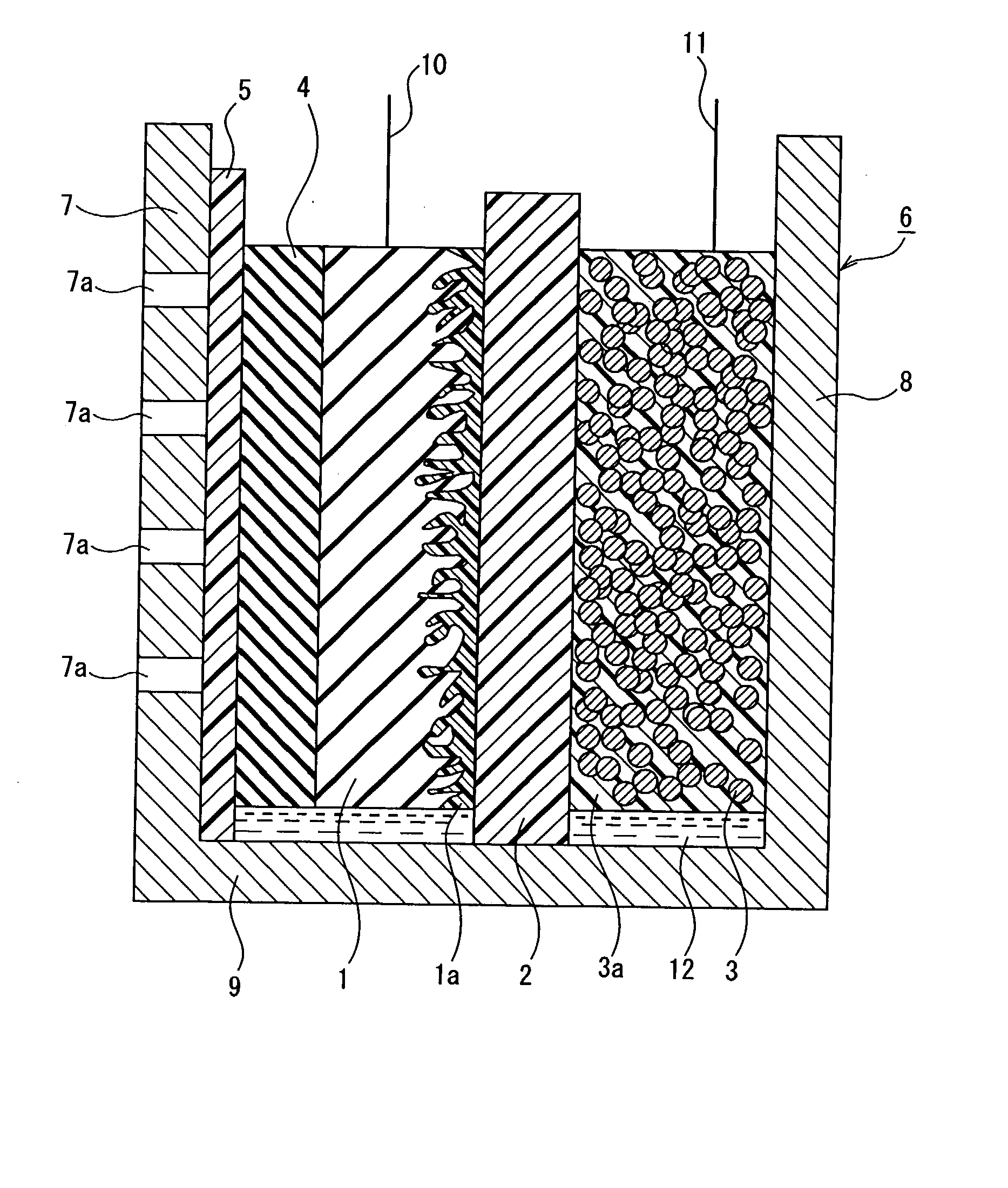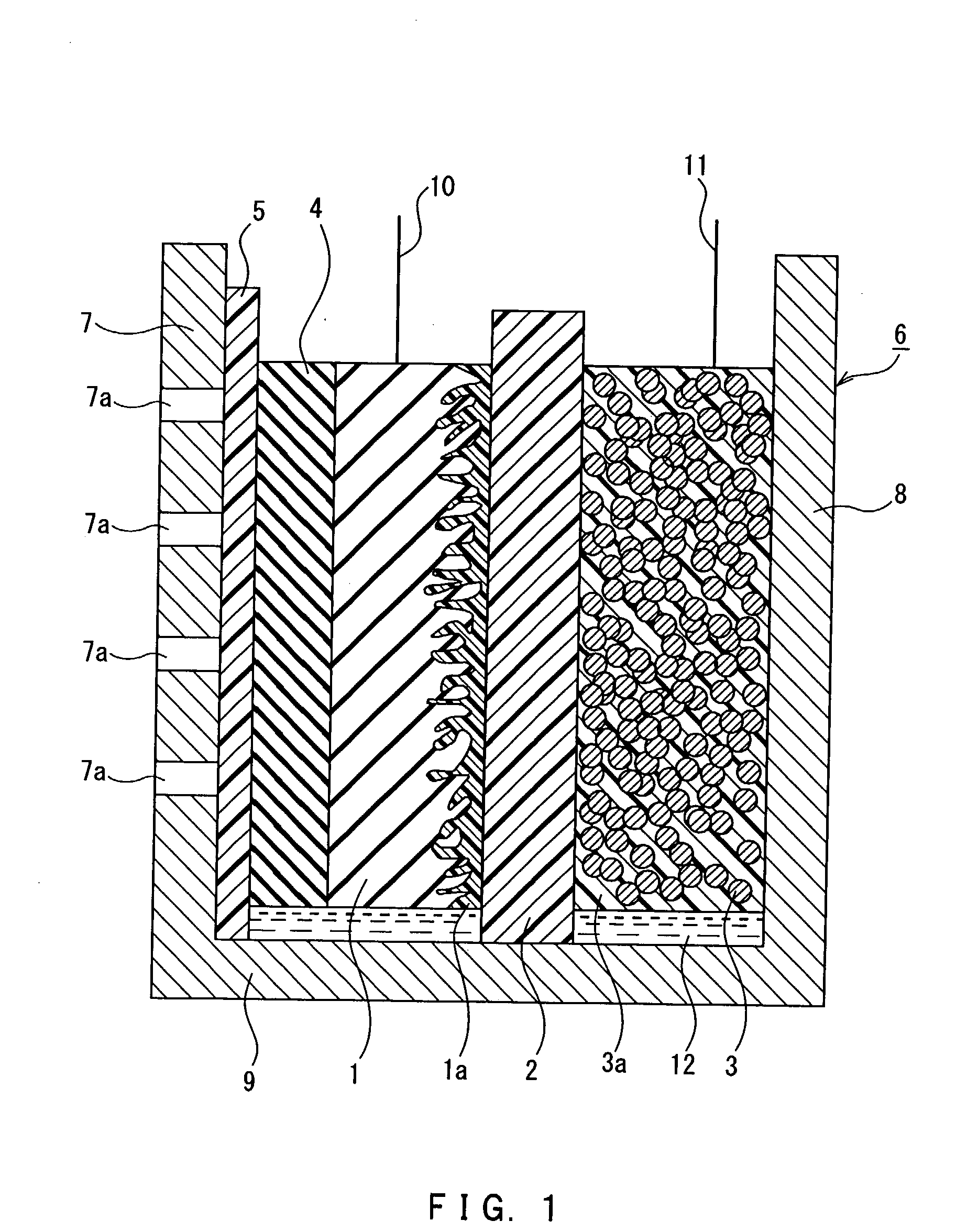Air-hydrogen cell
a hydrogen cell and air technology, applied in the field of airhydrogen batteries, can solve the problems of corroding of the hydrogen-absorbing alloy at a site, difficult to use the entire hydrogen-absorbing alloy for charging/discharging reactions, and difficult to move ions between anion-exchange resin powders, etc., to improve the utilization factor of the hydrogen-absorbing alloy and improve the cycle characteristics.
- Summary
- Abstract
- Description
- Claims
- Application Information
AI Technical Summary
Benefits of technology
Problems solved by technology
Method used
Image
Examples
example 2
[0068] First, 0.05 g of 6-dibutylamino-1,3,5-triazine-2,4-dithiol as a triazine thiol derivative was dissolved in 0.1 mol / dm.sup.3 of an aqueous solution of potassium hydroxide (50 cm.sup.3) to prepare a solution. Then, 10 g of the same hydrogen-absorbing alloy as that in Example 1 was added to the solution thus obtained, and the resultant mixture was stirred at 50.degree. C. for 30 minutes. Thereafter, the mixture was filtered and washed, and placed in a glass container, followed by drying at 65.degree. C. Using the hydrogen-absorbing alloy treated with 6-dibutylamino-1,3,5-triazine-2,4-dithiol, a negative electrode was produced in the same procedure as that in Example 1. The other configuration was set to be the same as that in Example 1, whereby an air-hydrogen battery was produced.
example 3
[0069] An air-hydrogen battery was produced by using an air electrode containing, as a catalyst, nickel powder that has polytetrafluoroethylene as fluorine resin together with silver plating on its surface. The detail thereof will be described below.
[0070] First, 2.158 g of nickel powder was placed in acetone, and degreased by ultrasonic washing for 10 minutes. Then, the nickel powder taken out from acetone was placed in a hydrochloric acid aqueous solution with a concentration of 10% by volume, and washed with an acid while stirring for 30 minutes. Thereafter, the nickel powder was washed with water until it became neutral. Thus, the nickel powder was pretreated.
[0071] The nickel powder was placed in 70 cm.sup.3 of distilled water. Then, 0.889 g of a dispersion in which 60% by mass of polytetrafluoroethylene was dispersed in 2 cm.sup.3 of ethanol was added to the nickel powder successively. After stirring for 5 minutes, the dispersion was dispersed ultrasonically for 10 minutes, wh...
example 4
[0075] Using a carbon material into the surface of which a C--F coupling was introduced by fluorination and a rare-earth oxide, an air electrode was produced as follows. First, carbon black "VULCAN XC-72" produced by CABOT was fluorinated to obtain fluorinated carbon in which about 5% by mass of fluorine was introduced. Then, 0.25 g of the fluorinated carbon and 0.125 g of La.sub.0.6Ca.sub.0.4CoO.sub.3 were added to 30 cm.sup.3 of distilled water. The mixture was stirred for 10 minutes. Then, 0.18 g of polytetrafluoroethylene aqueous dispersion with a concentration of 60% by mass was added to the mixture, and stirred for 20 minutes. Then, 8 cm.sup.3 of n-butanol was added to the resultant mixture, followed by stirring for 20 minutes. Then, the mixture was increased in temperature to 200.degree. C., and stirred for 20 minutes. Thereafter, an aggregate was precipitated, and a supernatant was removed to obtain an air electrode catalytic paste.
[0076] A carbon fiber plate electrode suppo...
PUM
| Property | Measurement | Unit |
|---|---|---|
| Energy density | aaaaa | aaaaa |
Abstract
Description
Claims
Application Information
 Login to View More
Login to View More - R&D
- Intellectual Property
- Life Sciences
- Materials
- Tech Scout
- Unparalleled Data Quality
- Higher Quality Content
- 60% Fewer Hallucinations
Browse by: Latest US Patents, China's latest patents, Technical Efficacy Thesaurus, Application Domain, Technology Topic, Popular Technical Reports.
© 2025 PatSnap. All rights reserved.Legal|Privacy policy|Modern Slavery Act Transparency Statement|Sitemap|About US| Contact US: help@patsnap.com



